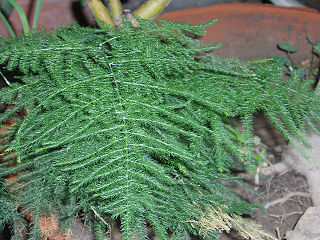
Asparagus is a genus of flowering plants in the family Asparagaceae, subfamily Asparagoideae. It comprises up to 300 species. Most are evergreen long-lived perennial plants growing from the understory as lianas, bushes or climbing plants. The best-known species is the edible Asparagus officinalis, commonly referred to as just asparagus. Some other members of the genus, such as Asparagus densiflorus, are grown as ornamental plants.
Plants belonging to the genus Pachypodium vary widely from each other in some aspects, but also share a number of basic common traits. Each species is adapted to the specific environment which it inhabits, but all species of the genus share certain anatomical and metabolic traits, reflecting their common evolutionary ancestry.

Alsophila dregei, synonym Cyathea dregei, is a widespread species of tree fern in southern Africa.

Ceropegia stapeliiformis is a flowering plant in the genus Ceropegia (Apocynaceae), native to South Africa and Swaziland. Common names include serpent ceropegia, snake creeper, and slangkambro.
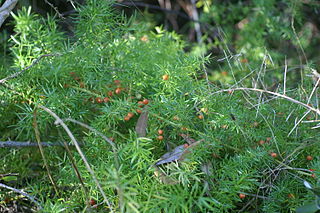
Asparagus aethiopicus, Sprenger's asparagus, is a plant native to the Cape Provinces and the Northern Provinces of South Africa. Often used as an ornamental plant, it is considered an invasive weed in many locations. Asparagus fern, asparagus grass and foxtail fern are common names; however, it is unrelated to true ferns. A. aethiopicus has been confused with A. densiflorus, now regarded as a separate species, so that information about A. aethiopicus will often be found under the name A. densiflorus.

Astartea fascicularis is a species of flowering plant in the myrtle family, Myrtaceae. It is endemic to southwestern Western Australia, where it is widespread in the Recherche Archipelago and present on the mainland in Cape Le Grand National Park. It is commonly known as Recherche astartea. or false baeckea.

Renosterveld is a term used for one of the major plant communities and vegetation types of the Cape Floristic Region which is located in southwestern and southeastern South Africa, in southernmost Africa. It is an ecoregion of the Mediterranean forests, woodlands, and scrub biome.

In botany, a fascicle is a bundle of leaves or flowers growing crowded together; alternatively the term might refer to the vascular tissues that supply such an organ with nutrients. However, vascular tissues may occur in fascicles even when the organs they supply are not fascicled.

Ochrosia moorei, known as the southern ochrosia is a rainforest plant of eastern Australia. Endangered by extinction, it has a ROTAP rating of 2ECi.
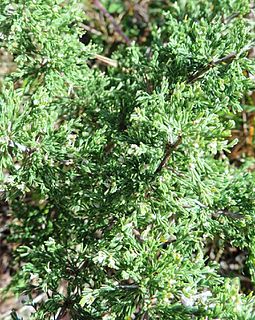
Asparagus capensis, also called katdoring is a dense, thorny, shrub of the Asparagus genus, that is indigenous to South Africa and Namibia.
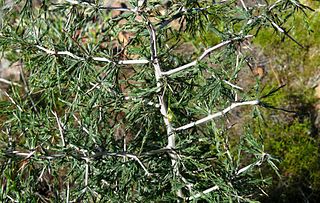
Asparagus lignosus ("Katdoring") is a thorny, spindly creeper of the Asparagus genus, that is indigenous to the Western Cape Province of South Africa.
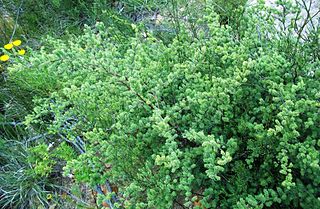
Asparagus rubicundus is a fluffy, thorny shrub of the Asparagus genus, that is indigenous to South Africa and southern Namibia.

Boscia foetida, commonly known as the stink shepherd's tree and the smelly shepherd's bush, is an evergreen shrub or tree that is native to the warmer and drier parts southern Africa. It is found in semi-desert and arid bushveld, and in the west it occurs commonly in areas which are otherwise sparsely wooded. It is known for the particularly unpleasant smell of its flowers which appear during early spring, to which its specific name foetida alludes. Its freshly cut wood likewise has an unpleasant smell, and has traditional medicinal and magical uses, for instance as a protection against lightning.

Duvalia elegans is a small succulent plant species, in the family Apocynaceae. It is the type species of the genus Duvalia, and it is endemic to the Western Cape Province, South Africa.

Asparagus striatus ("Bergappel") is a hard perennial shrublet of the Asparagus genus, that is indigenous to dry, rocky areas of South Africa.

Asparagus mucronatus ("Katdoring") is a thorny shrub or creeper of the Asparagus genus, that is indigenous to the southern Cape regions of South Africa.
Asparagus multiflorus is a robust shrub or climber of the Asparagus genus, that is indigenous to the southern Cape regions of South Africa.

Asparagus retrofractus is a shrub of the Asparagus genus that is indigenous to the western regions of South Africa.

Asparagus suaveolens, is a shrub of the Asparagus genus, that is indigenous to rocky areas in Africa, from Kenya to South Africa.
















